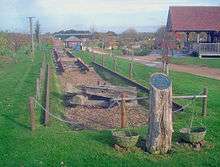Sumatra Railway
The Sumatra Railway, also referred to as the Pekanbaru Death Railway, was a railway project of the Imperial Japanese army in Sumatra during the Second World War. It was designed to connect Pekanbaru to Muaro in an effort to strengthen the military and logistical infrastructure for coal and troop shipments. The 220 km long railway would connect the Strait of Malacca, via the Siak River to Pekanbaru, to Padang via an existing railway from Muaro.

The railway was completed on Victory over Japan Day, 15 August 1945. It was only ever used to transport prisoners of war out of the area but quickly became overgrown by the jungle.[1][2]
Forced labour
Over 120,000 Indonesian, mostly Javanese, forced workers called Romusha were put to work by the Japanese army in addition to 6,500 Dutch prisoners of war, mostly Indo-Europeans, 1000 British prisoners of war, and a combined 300 prisoners of war from the United States, Australia and New Zealand. By the time the work was completed in August 1945 almost a third of the European POWs had died and only around 16,000 of the 120,000 Indonesian Romusha had survived.[2]
Accounts of construction
George Duffy, one of the 15 Americans there and survivor of the sinking of the MS American Leader recounted life and death for the POW workers on MemoryArchive: malaria, dysentery, pellagra, and malnutrition/"beri-beri" were the principal maladies compounded by overwork and mistreatment. "The average age at death of the 700 POWs who perished on that railway was 37 years and 3 months."[2]
Legacy and memorial

The railway was never fully utilised and remains unused and in an advanced state of decay.[4] The Japanese also directed construction of the Burma Railway and Kra Isthmus Railway (from Chumphon to Kra Buri).
The Sumatra Railway Memorial was unveiled on VJ Day in 2001 at the National Memorial Arboretum in Alrewas, England near Lichfield, Staffordshire. The memorial commemorates the approximately 5,000 prisoners of war and 30,000 locals who were forced to work on the 140-mile (230 km) Sumatra railway project and is located next to the Far East Prisoners of War Memorial Building.[1] The memorial's unveiling was attended by former prisoners of war, the Japanese ambassador to Britain (Sadayuki Hayashi) and included a peace stone and the planting of flowering trees to symbolise reconciliation.[1]
See also
- August Kop, Dutch Olympic medallist; died 30 April 1945 in Pekanbaru
- Far East prisoners of war
- Strategic railway
- Hellships
References
- Memorial to Sumatra railway dead 15 August 2001 BBC News
- Duffy, George (5 January 2006). "The Death Railway, April 1945". MemoryArchive. Archived from the original on 18 June 2008. Retrieved 2 January 2015.
- "Pekanbaru Death Railway", A page dedicated to the history and preservation of knowledge surrounding the Pekanbaru Death railway built by the Japanese and POWs during World War 2
- Hovinga, Henk (2010). The Sumatra Railroad: Final Destination Pakan Baroe 1943-45. Leiden: KITLV Press. ISBN 9789067183284.